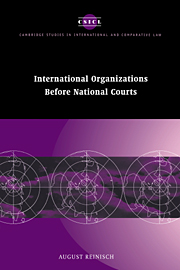Book contents
- Frontmatter
- Contents
- Preface
- Acknowledgements
- Table of cases
- Table of legal instruments
- List of abbreviations
- 1 Purpose, subject and methodology of this study
- PART I DESCRIPTIVE ANALYSIS
- 2 Avoidance techniques
- 3 Strategies of judicial involvement
- PART II POLICY ISSUES
- PART III FUTURE DEVELOPMENTS
- Bibliography
- Index
- Cambridge Studies in International and Comparative Law
3 - Strategies of judicial involvement
Published online by Cambridge University Press: 18 December 2009
- Frontmatter
- Contents
- Preface
- Acknowledgements
- Table of cases
- Table of legal instruments
- List of abbreviations
- 1 Purpose, subject and methodology of this study
- PART I DESCRIPTIVE ANALYSIS
- 2 Avoidance techniques
- 3 Strategies of judicial involvement
- PART II POLICY ISSUES
- PART III FUTURE DEVELOPMENTS
- Bibliography
- Index
- Cambridge Studies in International and Comparative Law
Summary
While the majority of cases involving international organizations before national courts certainly provoke the various avoidance techniques as outlined in chapter 2, judges might also actively seek to uphold jurisdiction over such disputes. In most cases, this will not be any purposeful assertion of jurisdiction, but rather a result of the clear inapplicability of a norm excluding international organizations from their jurisdiction, i.e. the absence of an applicable treaty norm requiring immunity, etc. Sometimes, however, denying immunity and upholding jurisdiction necessitates a more sophisticated reasoning. The organization affected could be ‘disqualified’ as an international organization which potentially enjoys immunity; an international rule requiring judicial abstention could be held to be inapplicable in the domestic realm; in the case of direct applicability of customary international law in the domestic legal order as a matter of principle, the existence of such a rule requiring the granting of immunity to international organizations might be denied; or an applicable rule providing for immunity might be limited in its scope, etc.
Most of the cases where national courts actively seek to exercise jurisdiction over disputes involving international organizations concern organizations as defendants whose potential immunity may deprive domestic tribunals of their adjudicative competence. Where international organizations appear as plaintiffs, national courts regularly have to address only the issue of whether to treat them like other persons under domestic law who are in a position to have recourse to judicial dispute settlement. This seemingly simple problem has proven thorny from time to time.
- Type
- Chapter
- Information
- International Organizations before National Courts , pp. 169 - 230Publisher: Cambridge University PressPrint publication year: 2000



